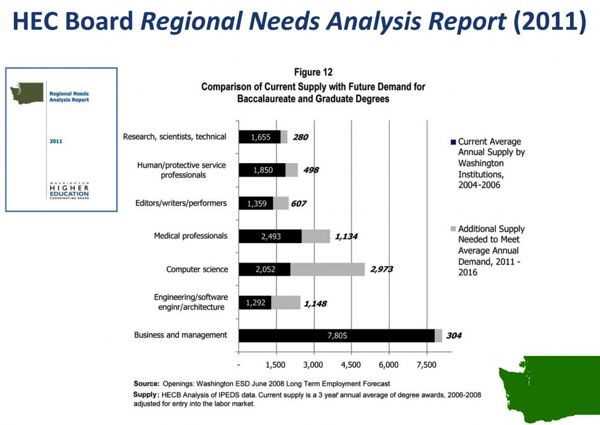Guest Commentary: For the fiscal year beginning July 1, 2011, the University of Washington has again taken a massive hit to its state budget. This will largely (but by no means entirely) be offset by tuition increases. The chart below shows state support and tuition revenues over the past 5 years:
You see that state support has dropped almost exactly 50% since 2007-08: from $433 million to $216 million annually. (Interestingly, state support in 1990-91 – 20 years ago – was $419 million (in constant dollars), about the same as in 2007-08, the year before the start of the current plummet.)
You also see that recent increases in tuition have not been sufficient to fully offset decreases in state funding.
The drop in state funding is even more stark on a per-student basis (due to modest enrollment increases over the past 5 years), as shown in the next chart:
On a per-student basis, state support has fallen 56% since 2007-08. (Per-student state support has fallen 64% since 1990-91, in constant dollars.) Total funding per student — tuition + state support — has fallen 19% since 2007-08.
This has inevitably caused significant budget reductions in academic units. Across the campus, the net effective cut to academic units over the past three years has been 16.2%.
The College of Engineering, where Computer Science & Engineering is housed, has suffered exactly this campus-wide average net effective cut: 16.2%.
However, there has been some differentiation across academic units. For example, the College of Arts & Sciences, whose permanent budget is nearly three times as large as that of the College of Engineering and which delivers many of the lower-division core courses for the University at large, saw a significantly smaller cut over the past three years – a net effective cut of only 5.5%, roughly 1/3 the campus-wide average. Some professional schools, such as the Information School, saw greater-than-average cuts. Overall, there is a disturbing trend of insufficient funding per student for the highest-impact STEM disciplines such as engineering and computer science, which are expensive to offer due to intensive upper-division laboratory experiences.
In this context, we again note the most recent regional and national workforce gap projections from (respectively) the State Higher Education Coordinating Board (citing ESD and IPEDS data) and the President’s Council of Advisors on Science and Technology (citing BLS and NSF data):

 (Additional information on the transformational role of computer science, and on student demand and employer demand, can be found here and here.)
(Additional information on the transformational role of computer science, and on student demand and employer demand, can be found here and here.)
There is only one way forward: The University of Washington must institute differential tuition: differential by field (because engineering fields are more expensive to teach than, e.g., the humanities and social sciences), and differential by year (because upper-division students are more expensive to educate than lower-division students). Additionally, units must be able to retain the vast majority of the tuition revenue that they generate, rather than having it retained centrally for re-distribution.
Only through these steps will it be possible for the State of Washington to have a UW College of Engineering, and a UW Department of Computer Science & Engineering, of the size and quality necessary for our collective future.
 Computer science professor Ed Lazowska holds the Bill & Melinda Gates Chair in Computer Science & Engineering at the University of Washington. Follow him on Twitter @lazowska. This post was reprinted with permission from the UW Computer Science and Engineering Department’s UW CSE News site.
Computer science professor Ed Lazowska holds the Bill & Melinda Gates Chair in Computer Science & Engineering at the University of Washington. Follow him on Twitter @lazowska. This post was reprinted with permission from the UW Computer Science and Engineering Department’s UW CSE News site.
Also see this recent GeekWire Podcast featuring Lazowska as a guest.





